A Double-Layer Patch Antenna for 5–6 GHz Wireless Communication
Abstract
:1. Introduction
2. Design and Analysis
2.1. Antenna Design
2.2. Theoretical Analysis
3. Parametric Study
4. Results and Discussion
4.1. Impedance Bandwidth
4.2. Broadside Gain
4.3. Radiation Pattern
4.4. Comparison Table and Application
5. Conclusions
Author Contributions
Funding
Conflicts of Interest
References
- Boon-Khai, A.; Boon-Kuan, C. A Wideband E-Shaped Microstrip Patch Antenna for 5-6 GHz Wireless Communications. Prog. Electromagn. Res. 2007, 75, 397–407. [Google Scholar]
- Li, L.; Zhang, X.; Yin, X.; Zhou, L. A Compact Triple-Band Printed Monopole Antenna for WLAN/WiMAX Applications. IEEE Antennas Wirel. Propag. Lett. 2016, 15, 1853–1855. [Google Scholar] [CrossRef]
- Jin, H.; Chin, K.; Che, W.; Chang, C.; Li, H.; Xue, Q. A Broadband Patch Antenna Array with Planar Differential L-Shaped Feeding Structures. IEEE Antennas Wirel. Propag. Lett. 2015, 14, 127–130. [Google Scholar] [CrossRef]
- Kai Fong, L.; Kin-Fai, T. Microstrip Patch Antennas. In Handbook of Antenna Technologies; Springer: Singapore, 2015. [Google Scholar] [CrossRef]
- Kaur, N.; Malhotra, S. A review on significance of design parameters of microstrip patch antennas. In Proceedings of the 2016 5th International Conference on Wireless Networks and Embedded Systems (WECON), Rajpura, India, 14–16 October 2016. [Google Scholar]
- Nascimento, D.C.; Fabiani, B.M.; Lacava, J.C.S. Performance Analysis of Probe-Fed Circularly-Polarized Moderately-Thick Microstrip Antennas Designed under the Null Reactance Condition. J. Microw. Optoelectron. Electromagn. Appl. 2018, 17, 1–9. [Google Scholar] [CrossRef]
- Farran, M.; Modotto, D.; Boscolo, S.; Locatelli, A.; Capobianco, A.D.; Midrio, M.; Ferrari, V. Compact Printed Parasitic Arrays for WLAN Applications. IEEE Antennas Wirel. Propag. Lett. 2016, 15, 918–921. [Google Scholar] [CrossRef]
- Li, W.; Xia, Z.; You, B.; Liu, Y.; Liu, Q.H. Dual-Polarized H-Shaped Printed Slot Antenna. IEEE Antennas Wirel. Propag. Lett. 2017, 16, 1484–14877. [Google Scholar] [CrossRef]
- Tariqul Islam, M.; Nazmus Shakib, M.; Misran, N. Broadband E-H Shaped Microstrip Patch Antenna for Wireless Systems. Prog. Electromagn. Res. 2009, 98, 163–173. [Google Scholar] [CrossRef] [Green Version]
- Mandal, K.; Sarkar, P.P. High Gain Wide-Band U-Shaped Patch Antennas With Modified Ground Planes. IEEE Trans. Antennas Propag. 2013, 61, 2279–2282. [Google Scholar] [CrossRef]
- Guan, C.; Fujimoto, T. Design of a Wideband L-Shape Fed Microstrip Patch Antenna Backed by Conductor Plane for Medical Body Area Network. Electronics 2020, 9, 21. [Google Scholar] [CrossRef] [Green Version]
- Tan, B.; Withington, S.; Yassin, G. A Compact Microstrip-Fed Planar Dual-Dipole Antenna for Broadband Applications. IEEE Antennas Wirel. Propag. Lett. 2016, 15, 593–596. [Google Scholar] [CrossRef]
- Yan, N.; Ma, K.; Zhang, H. A Novel Substrate-Integrated Suspended Line Stacked-Patch Antenna Array for WLAN. IEEE Trans. Antennas Propag. 2018, 66, 3491–3499. [Google Scholar] [CrossRef]
- Shi, W.; Qian, Z.; Ni, W. Dual-Band Stacked Annular Slot/Patch Antenna for Omnidirectional Radiation. IEEE Antennas Wirel. Propag. Lett. 2016, 15, 390–393. [Google Scholar] [CrossRef]
- Njoku, C.C.; Whittow, W.G.; Vardaxoglou, J.C. Simulation Methodology for Synthesis of Antenna Substrates With Microscale Inclusions. IEEE Trans. Antennas Propag. 2012, 60, 2194–2202. [Google Scholar] [CrossRef] [Green Version]
- Kiziltas, G.; Psychoudakis, D.; Volakis, J.L.; Kikuchi, N. Topology design optimization of dielectric substrates for bandwidth improvement of a patch antenna. IEEE Trans. Antennas Propag. 2003, 51, 2732–2743. [Google Scholar] [CrossRef]
- Malekpoor, H.; Jam, S. Enhanced Bandwidth of Shorted Patch Antennas Using Folded-Patch Techniques. IEEE Antennas Wirel. Propag. Lett. 2013, 12, 198–201. [Google Scholar] [CrossRef]
- Podilchak, S.K.; Caillet, M.; Lee, D.; Antar, Y.M.; Chu, L.C.; Cain, J.; Hammar, M.; Caldwell, D.; Barron, E. A Compact Circularly Polarized Antenna Using an Array of Folded-Shorted Patches. IEEE Trans. Antennas Propag. 2013, 61, 4861–4867. [Google Scholar] [CrossRef]
- Lau, K.L.; Wong, S.H.; Luk, K.M. Wideband Folded Feed L-Slot Folded Patch Antenna. IEEE Antennas Wirel. Propag. Lett. 2009, 8, 340–343. [Google Scholar] [CrossRef]
- Row, J.; Liou, Y. Broadband short-circuited triangular patch antenna. IEEE Trans. Antennas Propag. 2006, 54, 2137–2141. [Google Scholar] [CrossRef]
- Muhammad, A.; Jing, S.H.; Chao, M.L. Gain enhancement in cubic DRA with modified microstrip feed for WLAN applications. IEICE Electron. Express 2017, 14, 960–967. [Google Scholar]
- Leeladhar, M.; Rajib, K.P.; Machavaram, V. Circularly Polarized 2 × 2 MIMO Antenna for WLAN Applications. Prog. Electromagn. Res. 2016, 66, 97–107. [Google Scholar]
- Naser-Moghadasi, M.; Sadeghzadeh, R.A.; Hafezifard, R.; Yazdanifard, S.O.; Virdee, B.S. Highly compact meander line antenna using DGS technique for WLAN communication systems. IECE Electron. Express 2011, 8, 722–729. [Google Scholar] [CrossRef] [Green Version]
- Yong, W.P. Study of Microstrip Patch Antenna for 5 GHz. Korea Inf. Soc. Dev. Inst. 2019, 14, 55–60. [Google Scholar]

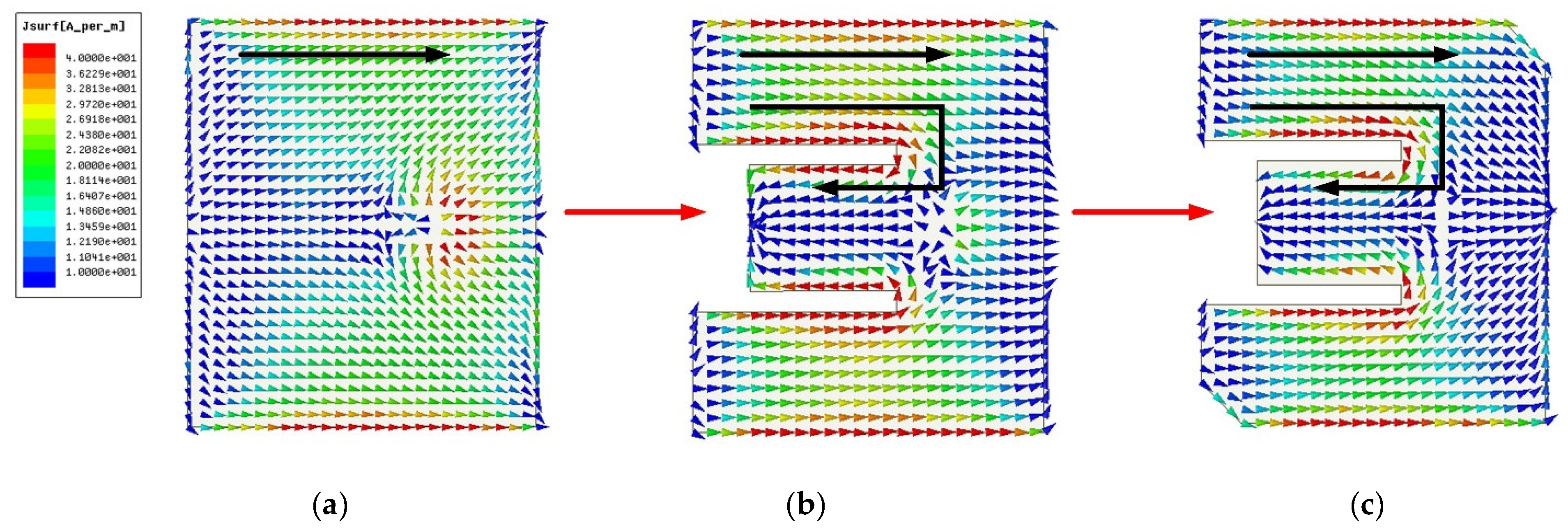
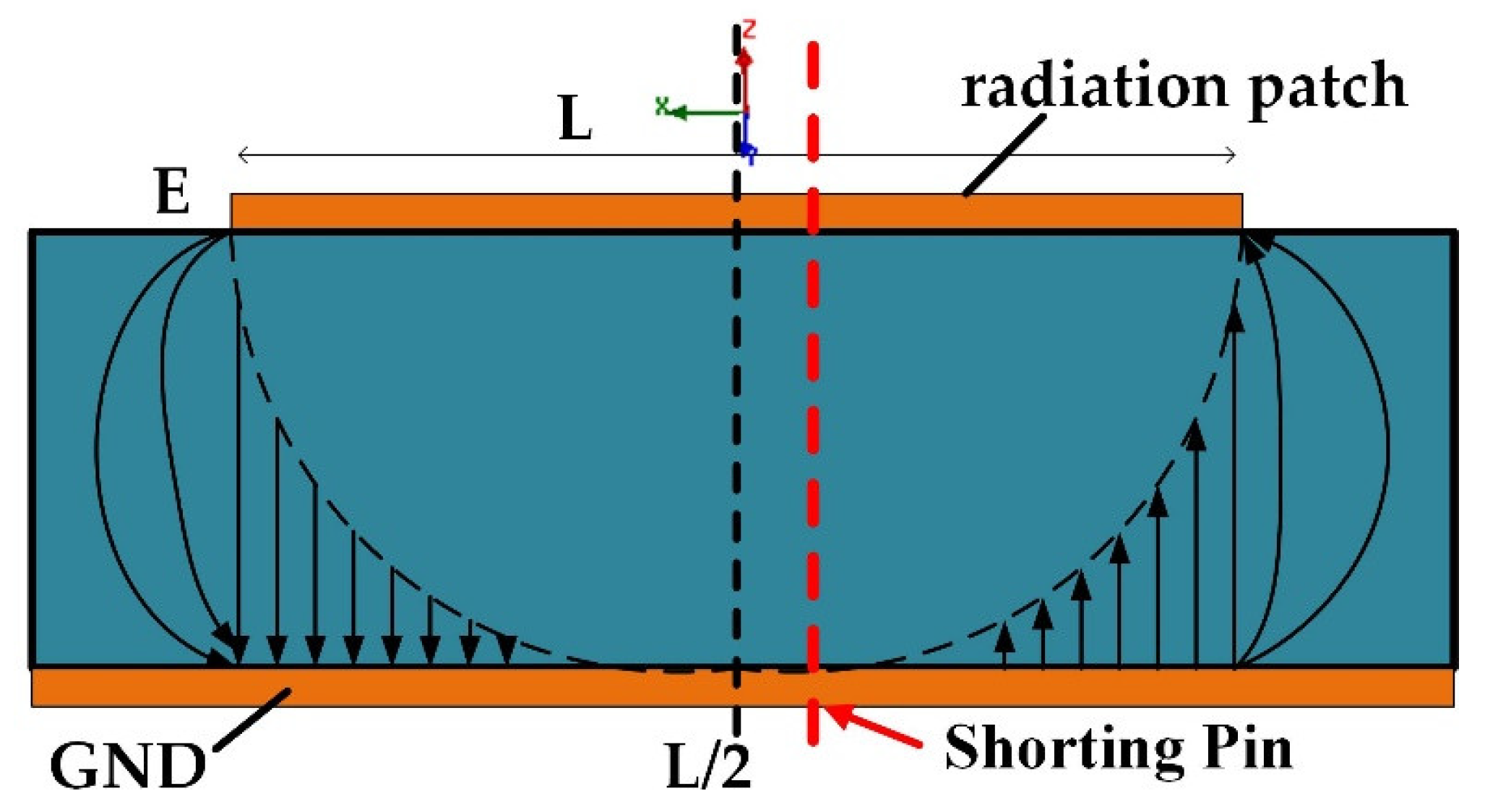
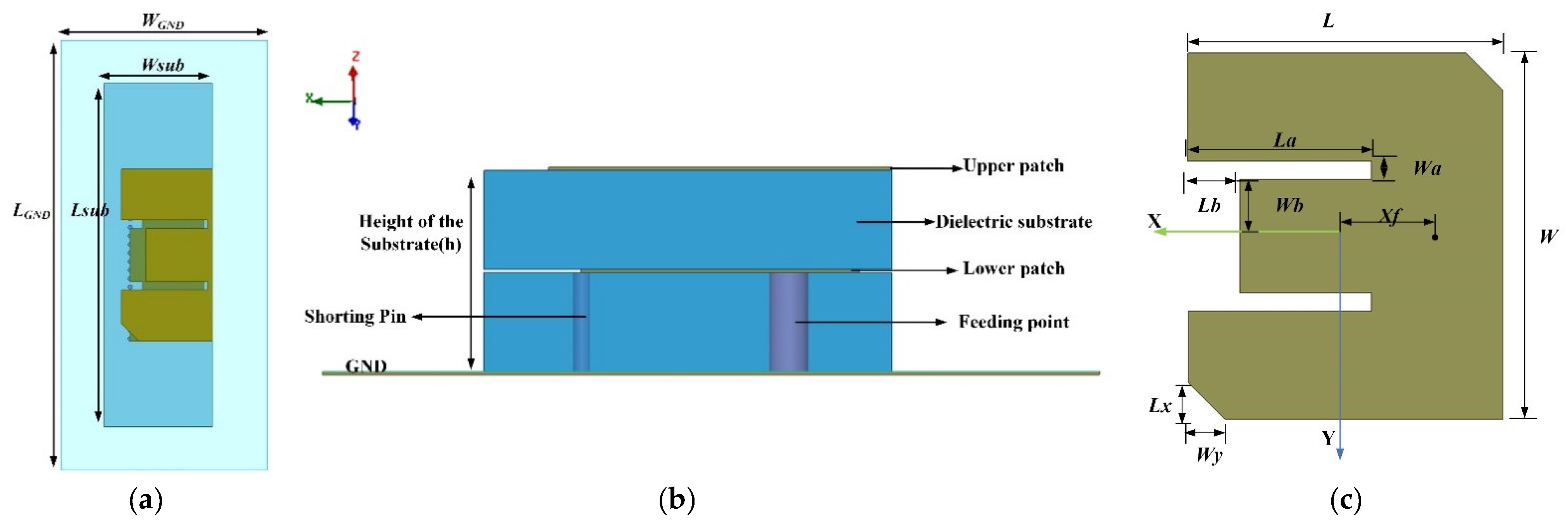
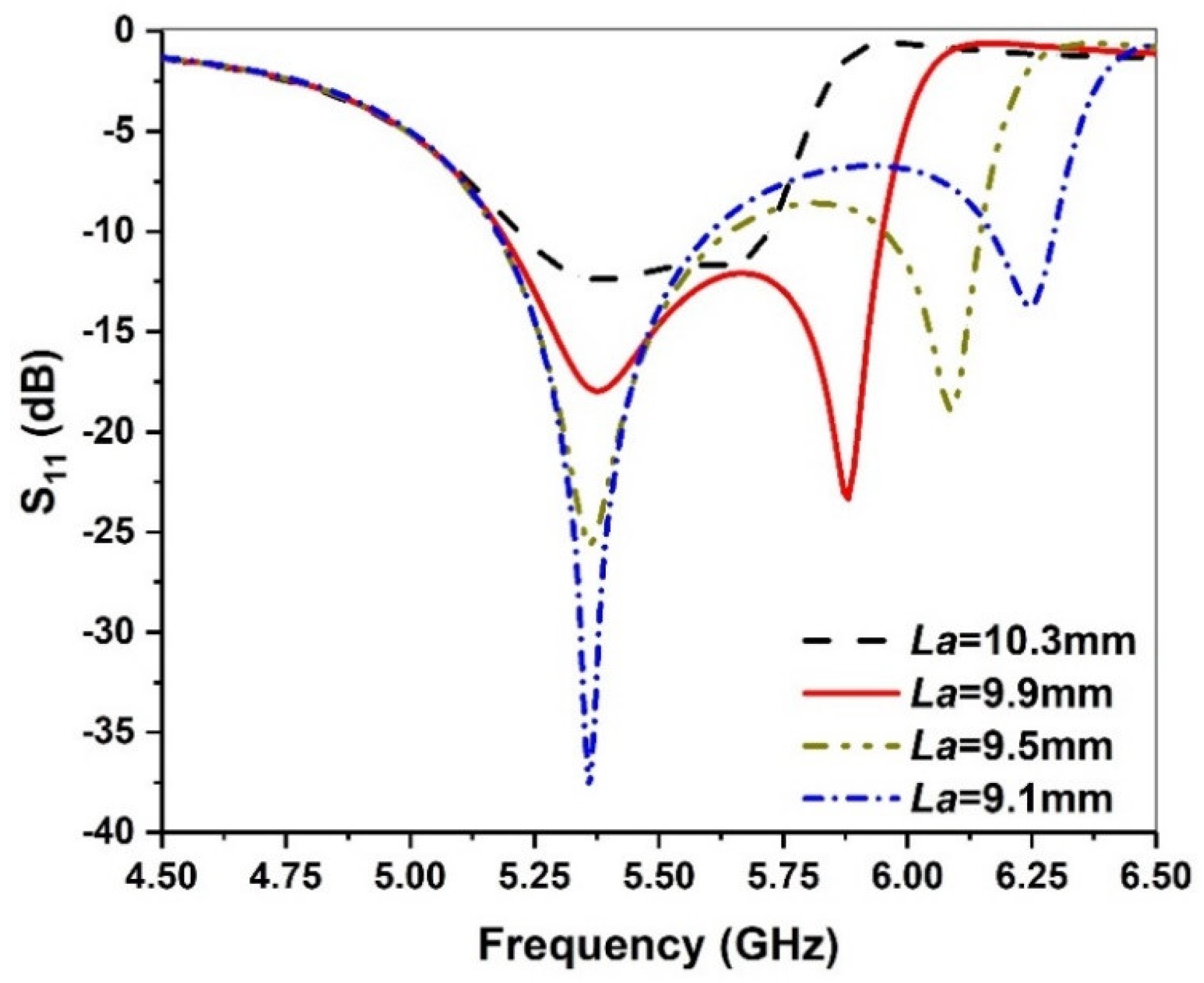
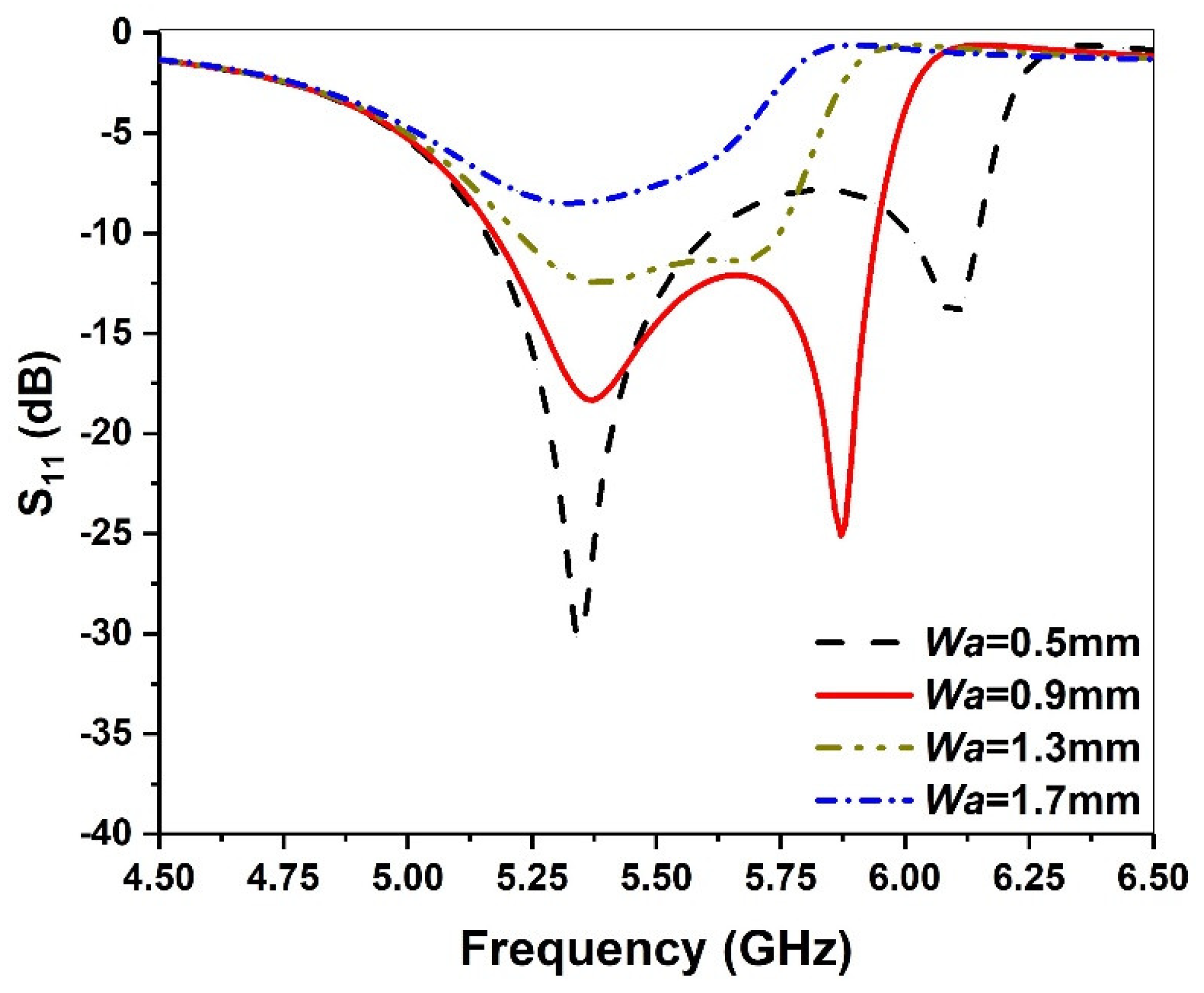

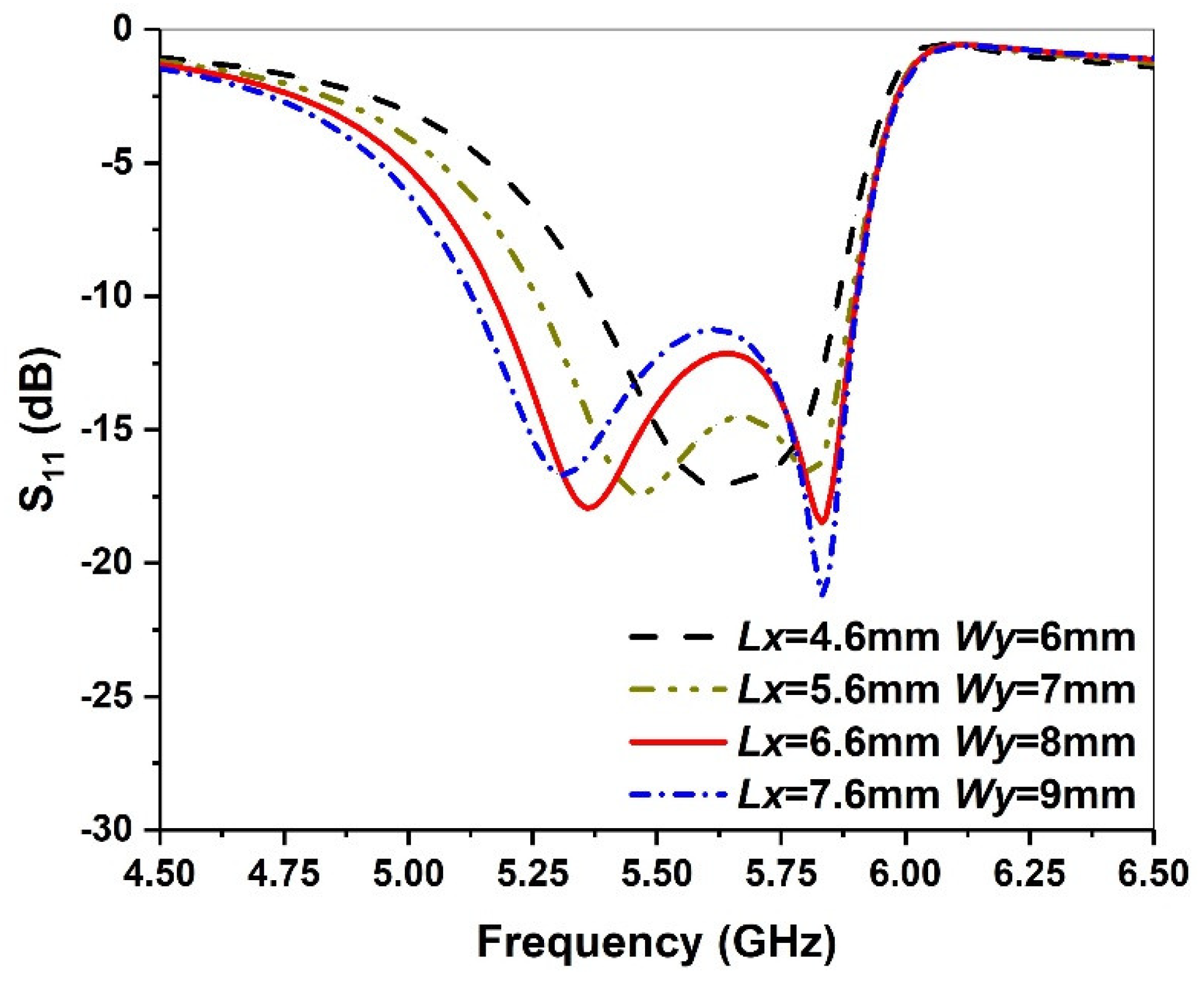
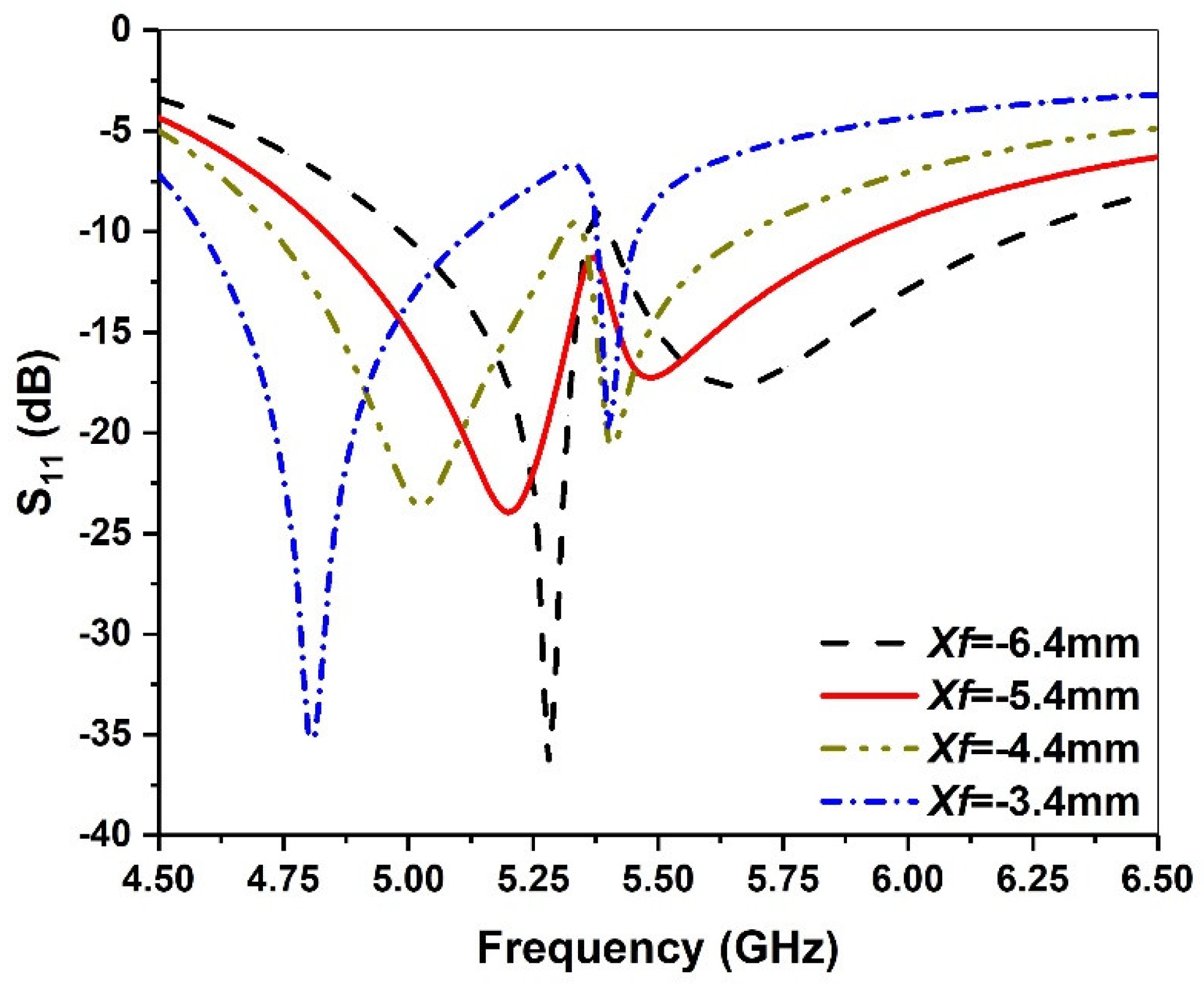
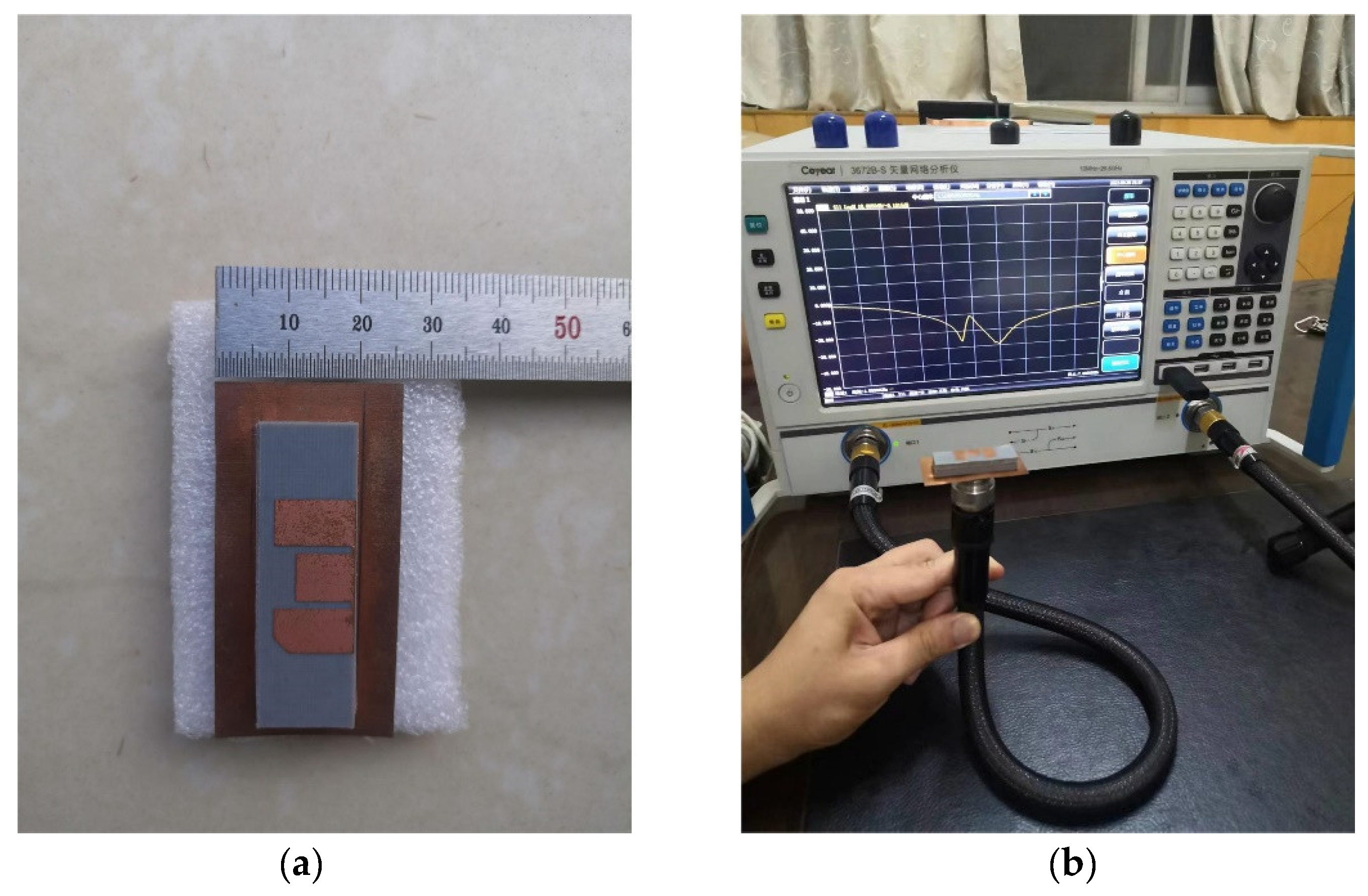
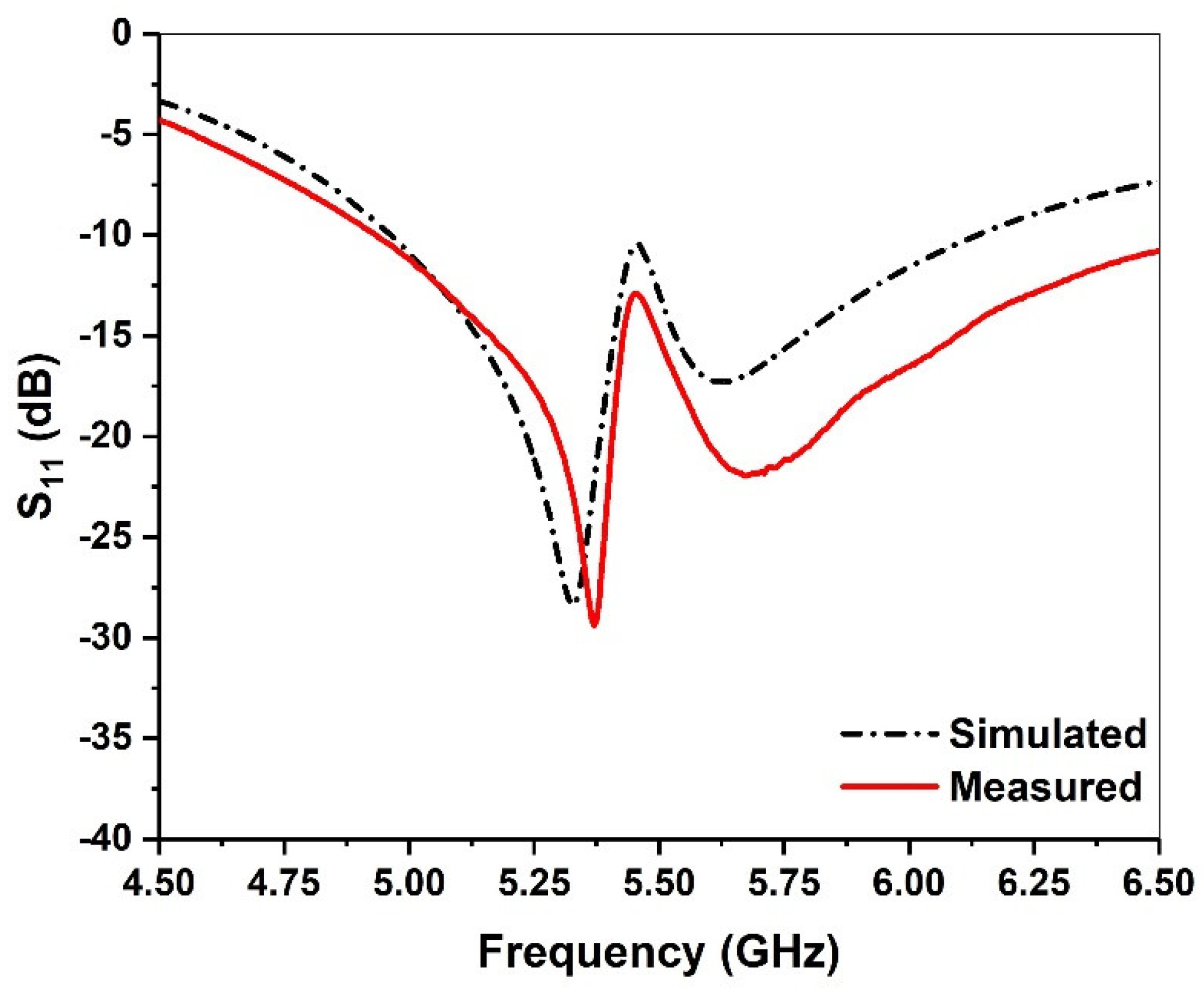
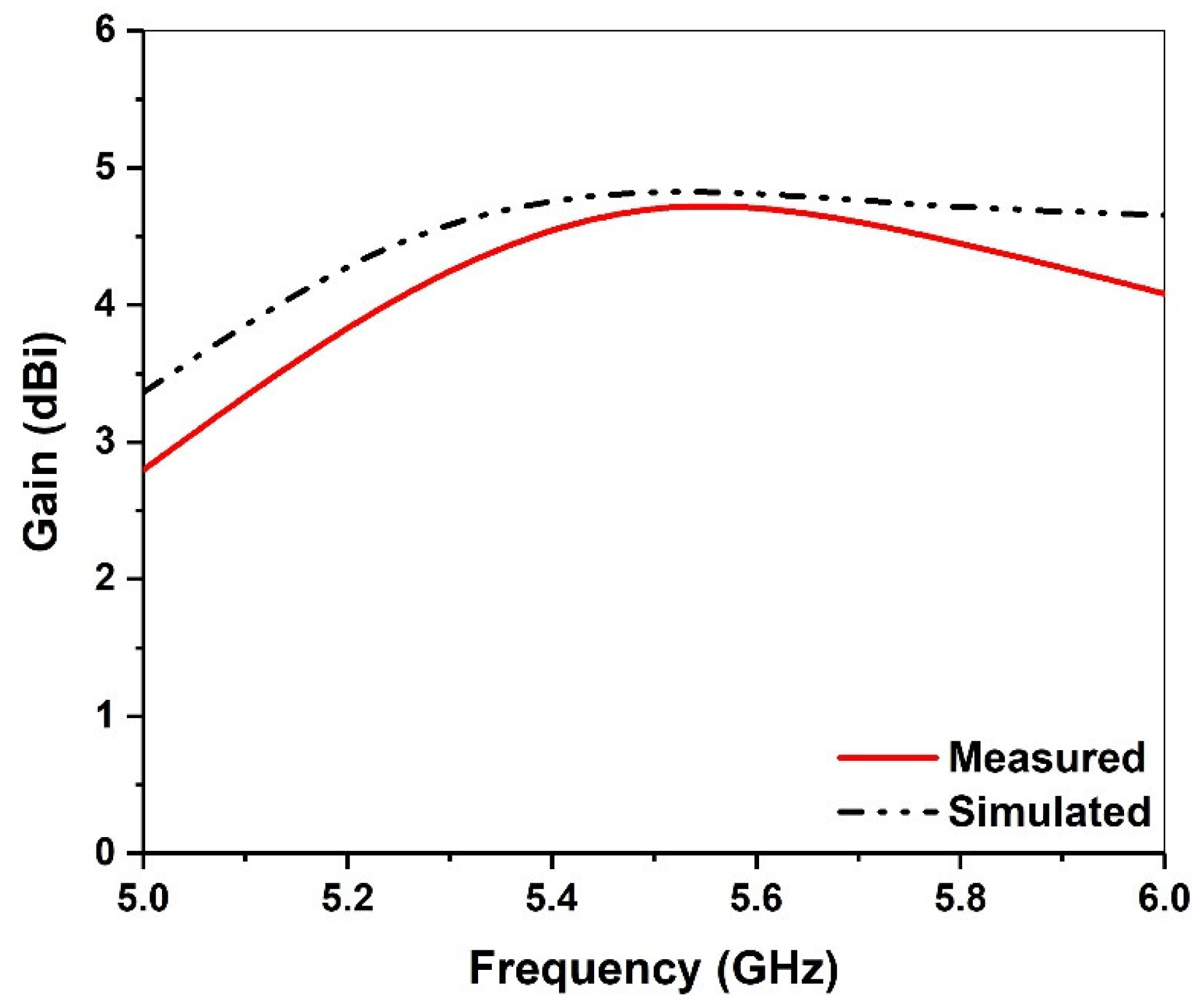
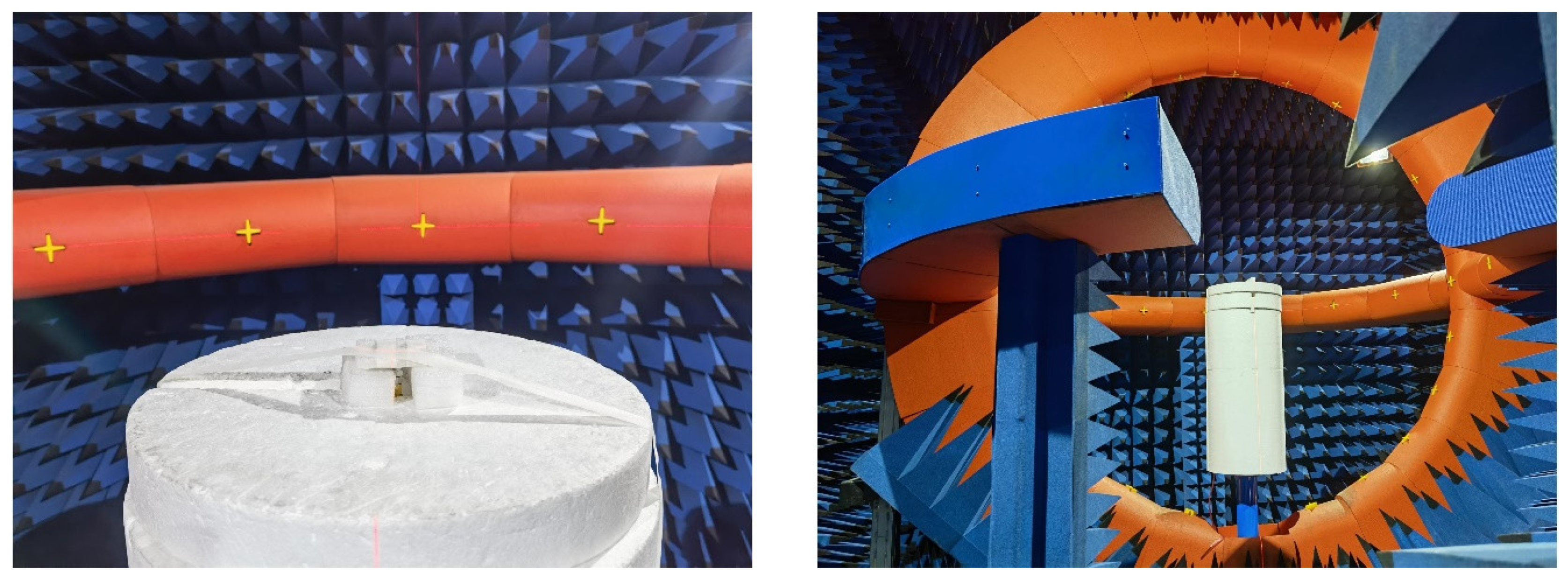
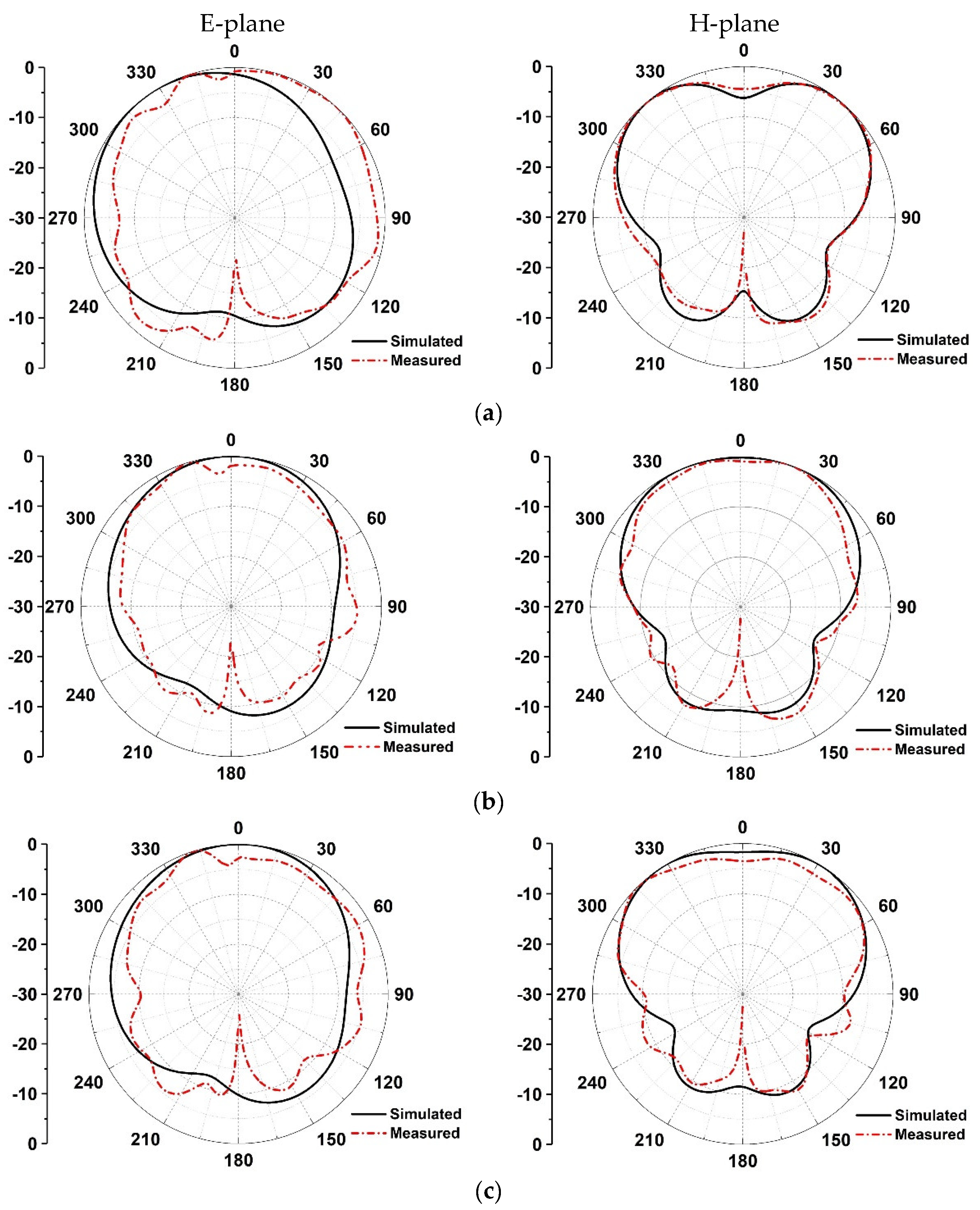
| Parameter | LGND | WGND | Lsub | Wsub | L | W | La | Wa | Lb | Wb | Lx | Wy | h | Xf |
|---|---|---|---|---|---|---|---|---|---|---|---|---|---|---|
| Unit (mm) | 40 | 25 | 35 | 12 | 17.2 | 20 | 9.9 | 0.9 | 2.9 | 3.2 | 6.6 | 8 | 6.1 | −5.4 |
| Ref. | Physical Size (mm2) | Electrical Size (λ02) | Bandwidth (GHz) | Gain (dBi) |
|---|---|---|---|---|
| [1] | 40 × 60 | 0.73 × 1.1 | 15.3% (5.05–5.85) | 7.5 |
| [21] | 54 × 100 | 1 × 1.8 | 2.5% (5.725–5.850) | 9 |
| [22] | 28 × 97 | 0.51 × 1.7 | 9.7% (5.49–6.024) | 5.23 |
| [23] | 19.5 × 10 | 0.36 × 0.2 | 13% (5.15–5.85) | 4.1 |
| [24] | 29.5 × 21 | 0.55 × 0.39 | 4.7% (5.27–5.53) | n/a |
| This work | 25 × 40 | 0.45 × 0.73 | 23% (4.83–6.1) | 4.7 |
Publisher’s Note: MDPI stays neutral with regard to jurisdictional claims in published maps and institutional affiliations. |
© 2022 by the authors. Licensee MDPI, Basel, Switzerland. This article is an open access article distributed under the terms and conditions of the Creative Commons Attribution (CC BY) license (https://creativecommons.org/licenses/by/4.0/).
Share and Cite
Li, X.-P.; Ma, M.-R.; Zhang, Q.-M.; Yan, L.; Wang, C.-Q.; Li, W. A Double-Layer Patch Antenna for 5–6 GHz Wireless Communication. Micromachines 2022, 13, 929. https://doi.org/10.3390/mi13060929
Li X-P, Ma M-R, Zhang Q-M, Yan L, Wang C-Q, Li W. A Double-Layer Patch Antenna for 5–6 GHz Wireless Communication. Micromachines. 2022; 13(6):929. https://doi.org/10.3390/mi13060929
Chicago/Turabian StyleLi, Xue-Ping, Ming-Rong Ma, Qi-Meng Zhang, Lin Yan, Chang-Qing Wang, and Wei Li. 2022. "A Double-Layer Patch Antenna for 5–6 GHz Wireless Communication" Micromachines 13, no. 6: 929. https://doi.org/10.3390/mi13060929
APA StyleLi, X.-P., Ma, M.-R., Zhang, Q.-M., Yan, L., Wang, C.-Q., & Li, W. (2022). A Double-Layer Patch Antenna for 5–6 GHz Wireless Communication. Micromachines, 13(6), 929. https://doi.org/10.3390/mi13060929





